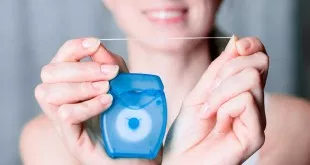 It’s probably something that gets repeated every time you or your child visit the dentist: “Don’t forget to floss every day.”
It’s probably something that gets repeated every time you or your child visit the dentist: “Don’t forget to floss every day.”
This is such an important routine to begin as early as when the first two baby teeth are touching; if there is not a wide enough gap for the toothbrush bristles to fit through, it’s time to start flossing.
Cavities can start on any surface of the tooth, but the most common spots are the pits and fissures and the interproximal surfaces (in between the teeth). By eating and drinking healthy, brushing twice a day for the appropriate amount of time (2 minutes) and flossing at least once a day, patients can lower their caries risk and reduce gingivitis.
Which Floss Is Best?
There are many different kinds of floss available today: traditional string floss, super floss (a thicker interwoven thread floss), floss sticks, and water flossers. Parents often ask what the best one is, and the answer is simple: the one you are most like to use consistently and properly. Personally, I’m a fan of traditional floss. It is more difficult for kids to do on their own, so parents may have to help up until about age 10, but it is the most affordable and effective.
Flossing Technique 101
The proper technique for traditional floss is to get approximately 18 inches of floss and wrap it around your middle fingers to create a tight tension, then use your index fingers to slide the floss through the contact, pull the floss against one tooth in a “C” shape and sweep the side of the tooth in an up and down motion (not side to side). Then pull the floss against the other tooth and do the same motion until you have swept every interproximal surface in your mouth. As you floss, unwrap one middle finger and rewrap the other to expose clean floss as you move along.
Floss sticks are a good introduction for kids, but I have found that the floss line develops too much slack and it makes it more difficult to floss tight contacts, especially in the molar areas; so children may think they are flossing, but if the floss does not fully slide through the contact, they are missing critical areas. Also, you have to rinse or wipe clean the floss as you move along.
Water flossers are the new fad, but can be a bit pricey as well as messy. I believe a water flosser is a good adjunct to flossing, especially for children in braces, but it does not fully sweep through the contact like traditional floss. So I still recommend flossing as well and to use floss threaders if the child is in braces.
Flossing is such an integral part of maintaining healthy oral hygiene. If you are having trouble, ask your dentist or hygienist for tips and instruction on how to properly floss your child’s teeth, or what products may be best for you.
Melissa McCool, DDS, is a proud Reno mom and is a pediatric dentist at The Smile Shop.

 Reno Moms Blog Building a Community of Moms in the Biggest Little City
Reno Moms Blog Building a Community of Moms in the Biggest Little City
